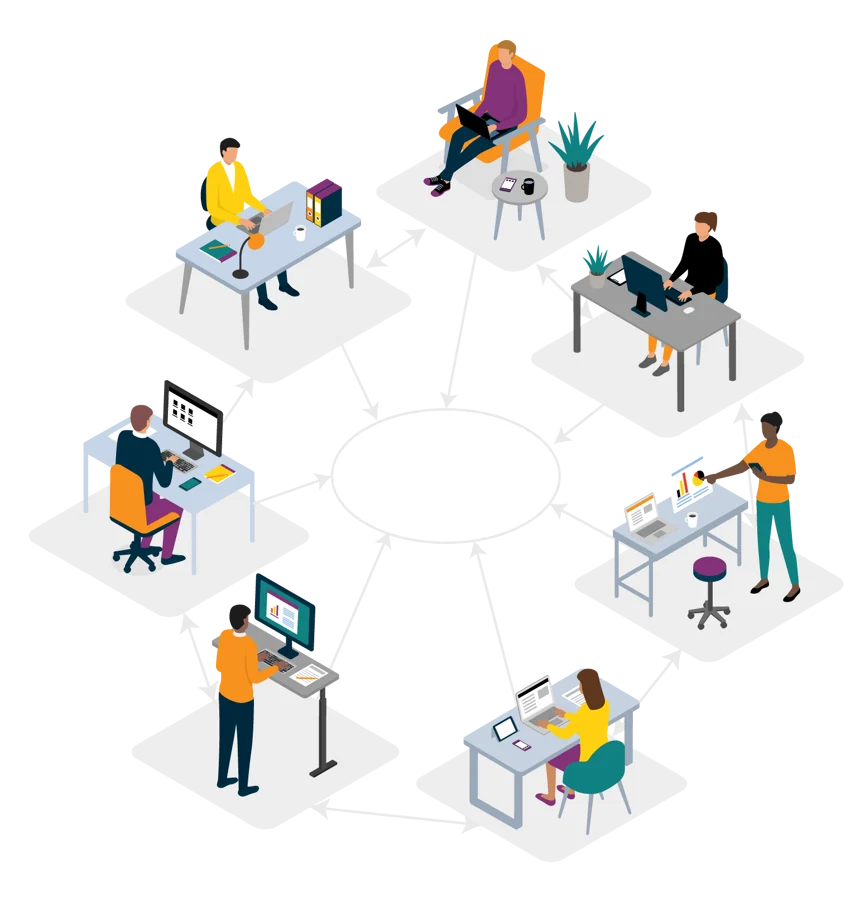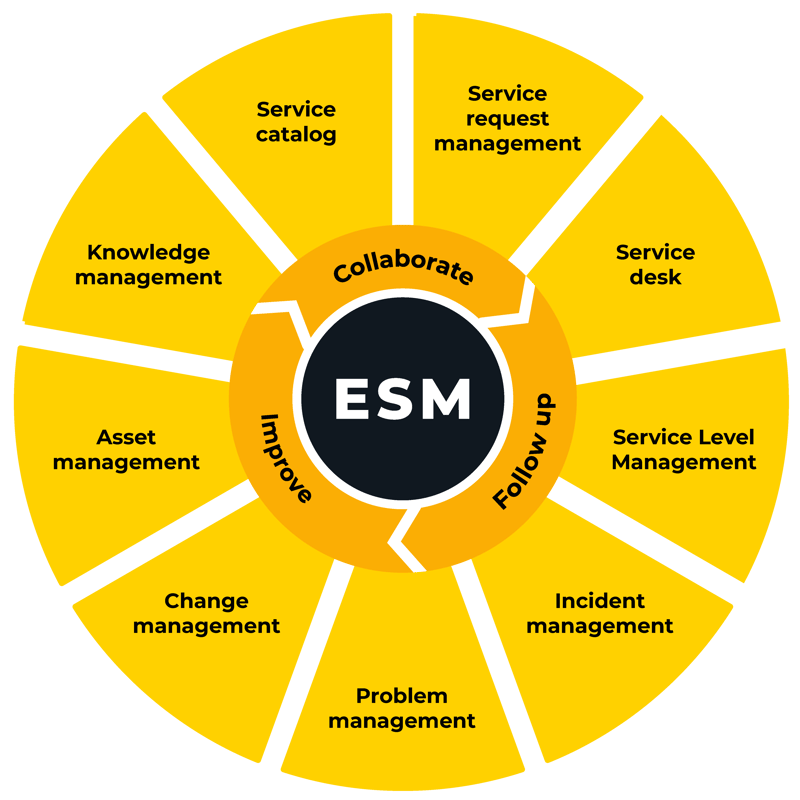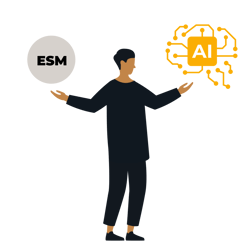En plan för Enterprise Service Management
Anamma Enterprise Service Management för att nå framgång
Fram till 2032 väntas sektorn för lösningar och tjänster inom service management växa mer än tre gånger från 2024. Det är i genomsnitt över 15% årlig tillväxttakt. Fortune Business Insights
Om du arbetar i ett serviceteam, t.ex. inom HR, fastighet, ekonomi eller marknadsföring, är chansen stor att du har infört ITSM-programvara som hjälper dig att hantera din arbetsbörda, och varför skulle du inte göra det med tanke på de funktioner för hantering av serviceförfrågningar, problem och förändringar som finns i dessa program?
Även om de är användbara på ytan gör de sannolikt ditt arbete mer komplext, eftersom programvara som är gjord för IT-team har funktioner och processer som är irrelevanta för din avdelning.
Enterprise Service Management (ESM) är en alternativ lösning som sträcker sig längre än ITSM:s principer och metoder för att tillgodose olika avdelningars behov och anpassa dem till affärsmålen.
Det handlar inte om Enterprise Service Management vs. ITSM; ESM är inte bara ett resultat av ITSM, utan ramverken kan användas tillsammans, vilket du kommer att lära dig när du läser vidare.
Innehållsförteckning
Del 1
Vad är Enterprise Service Management?
ESM fokuserar på att tillämpa serviceorienterade metoder, affärsprocesser och verktyg för att förbättra tjänsteleverans, effektivitet och samarbete mellan olika funktioner och avdelningar.
Lösningarna hjälper till att effektivisera arbetsflöden, förbättra kommunikationen och anpassa tjänsterna till affärsmålen, vilket i slutändan leder till bättre resultat och upplevelser för dig, dina kollegor och dina kunder.
Inom Enterprise Service Management fungerar marknadsstorleken som ett mått på hur effektiva lösningarna är när det gäller att tillgodose verksamhetens behov och öka produktiviteten.
Principer för Enterprise Service Management
När du närmar dig service management är det viktigt att förstå de principer som kan hjälpa dig att navigera och bidra till en serviceorienterad kultur.
- Serviceorientering: ESM har ett serviceorienterat förhållningssätt som fokuserar på att leverera värde till interna och externa kunder genom definierade tjänster.
- Integration: ESM betonar vikten av att integrera olika affärsfunktioner och processer för att effektivisera och förbättra verksamheten. Detta leder ofta till sänkta kostnader.
- Kundfokus: ESM prioriterar dina kunders behov och förväntningar, både interna och externa, genom att anpassa tjänsterna till deras önskemål.
- Standardisering: ESM strävar efter att standardisera processer och rutiner i hela organisationen för att säkerställa enhetlighet och tillförlitlighet i tjänsteleveransen.
- Ständiga förbättringar: ESM främjar en kultur av ständiga förbättringar, där processer, tjänster och arbetsflöden regelbundet granskas och förbättras för att öka effektiviteten.
- Samarbete: ESM uppmuntrar samarbete mellan olika avdelningar och team för att optimera resurser, dela kunskap och lösa problem.
- Automatisering: ESM använder automatiseringsverktyg och -tekniker för att automatisera rutinuppgifter, minska manuella insatser och öka produktiviteten.
- Styrning: ESM etablerar ramverk för styrning för att säkerställa att de tjänster du levererar är i linje med dina affärspolicys, regler och standarder.
- Mätningar och nyckeltal: ESM förlitar sig på nyckeltal för att övervaka effektiviteten i era tjänster och identifiera områden som kan förbättras.
- Flexibilitet och skalbarhet: ESM-verktygen är utformade för att vara flexibla och skalbara, så att ditt företag kan anpassa sig till förändrade behov och skala i enlighet med detta.
Vad ESM består av
Service catalog
Är din centrala databas för åtkomst till och begäran om tjänster som stöd för ditt arbete. Genom att effektivt hantera tjänstekatalogen inom ett ESM-ramverk kan du effektivisera tjänsteleveransen, förbättra användarnöjdheten och öka den operativa effektiviteten mellan olika avdelningar.
Hantering av service requests
Innebär att hantera och uppfylla förfrågningar från användare på ett effektivt sätt inom en organisation med slutmålet att förbättra kundnöjdheten. Det omfattar att ta emot förfrågningar, kategorisera dem, automatisera arbetsflöden, uppfylla förfrågningar, kommunicera med förfrågare och spåra framsteg.
Servicedeskar
En ESM-servicedesk utökar sitt stöd bortom IT för att hantera ett bredare spektrum av förfrågningar från olika avdelningar. Det kan handla om HR-avdelningen för frågor om företagspolicyer, onboarding etc., ekonomiavdelningen för godkännande av utlägg, budgetfrågor, ersättningar etc. ochmarknadsavdelningen för förfrågningar om material, kampanjspårning och liknande.
Service desk-verktyg innehåller vanligtvis de flesta ITIL-processer, inklusive kapacitetshantering.
Service Level Management (SLM)
Fokuserar på att definiera, förhandla och hantera service level agreements (SLA) mellan tjänsteleverantörer och kunder på avdelningsnivå. Dessa SLA:er fastställer tydliga förväntningar, ansvarsområden och prestationsmål för leverans av tjänster, oavsett om de är IT-relaterade eller inte.
Hantering av incidenter
När problem rapporteras förs detaljerade register som hjälper dig att avgöra vilka som behöver åtgärdas omedelbart. Användarna hålls uppdaterade om hur arbetet med att åtgärda problemen fortskrider. När ett problem är löst kan du undersöka varför det inträffade och förhindra att det upprepas.
Hantering av problem
Handlar om att identifiera och åtgärda grundorsaken till problem inom organisationen. Genom effektiv problemhantering ger ESM dig möjlighet att förbättra tjänsternas tillförlitlighet, minimera störningar och optimera den operativa effektiviteten på ett holistiskt sätt.
Hantering av förändringar
Handlar om transparens och samarbete mellan dina intressenter. Det handlar om processer för inlämning av ändringsbegäran och bedömningar av hur förändringar påverkar hela verksamheten. Överväganden omfattar risker, fördelar, resursbehov och anpassning till övergripande mål.
Hantering av tillgångar
Varierar beroende på din avdelning. Inom Enterprise Service Management är exempel kontorsmöbler, maskiner, fordon, anläggningar, utrustning och resurser som stöder affärsverksamheten.
Knowledge management
Innebär att samla in, organisera och dela information och insikter i hela verksamheten. Om du till exempel arbetar med marknadsföring kan material som varumärkesriktlinjer, broschyrer och kampanjfokus lagras och delas inom hela företaget eftersom de ofta innehåller information om varumärkets identitet, produkter eller tjänster, målgrupp etc.
Sammanfattningsvis handlar ESM om att underlätta rätt processer, verktyg och arbetsflöden för högproduktiva organisationer där avdelningarna arbetar bra tillsammans. Det innebär att du måste ha ett företagsövergripande fokus där du måste integrera med dina befintliga system och återanvända det du har (om det gynnar verksamheten).
Del 2
Vad Enterprise Service Management inte är
ESM handlar inte bara om IT
ITSM och ESM är inte samma sak. ITSM gynnar främst IT-team, medan Enterprise Service Management gör det möjligt för företag att ta itu med utmaningar på flera avdelningar, t.ex. HR, ekonomi, anläggningar, kundtjänst och så vidare.
ESM handlar inte bara om teknik
Även om tekniken spelar en viktig roll för att stödja ESM-initiativ genom verktyg för tjänstehantering, t.ex. servicedeskar, handlar det i grunden om att förbättra tjänsteleveransen och den operativa effektiviteten i hela företaget. Det handlar om att anpassa människor, processer och teknik för att leverera värde till interna och externa kunder.
ESM är inte en lösning som passar alla
Det finns inte ett enda ramverk eller en enda metod för Enterprise Service Management som passar alla organisationer. Det kräver anpassning och anpassning till specifika behov, eftersom varje organisation har sina egna utmaningar och mål.
ESM handlar inte bara om effektivitet
Att förbättra den operativa effektiviteten är ett vanligt mål, men det är inte det enda fokuset. ESM syftar till att förbättra servicekvalitet, kundupplevelser och affärsresultat. Det handlar om att främja en kultur av ständiga förbättringar och innovation för att möta verksamhetens tillväxt och kundernas förväntningar.
ESM är inte ett isolerat initiativ
För att implementera en ESM-lösning behöver du stöd från olika avdelningar och intressenter. Detta innebär att man måste bryta ner silos och främja tvärfunktionellt samarbete för att uppnå gemensamma mål. ESM-initiativ kräver kontinuerlig kommunikation för att driva organisationsförändringar på ett effektivt sätt.
ESM är inte något att vara rädd för
Det kan vara skrämmande att byta från välbekanta rutiner och strukturer, men att släppa kontrollen över uppgifter och arbetsflöden kommer i slutändan att göra ditt liv enklare.

Del 3
Fördelarna med Enterprise Service Management för business team
Varför är Enterprise Service Management viktigt för business team?
När det gäller Enterprise Service Management är fördelar som snabba lösningar och förbättrat samarbete - ett resultat av strukturerad work flow management och strömlinjeformad kommunikation - viktiga försäljningsargument. Business team hanterar ofta tidskänsliga projekt, så det är viktigt att kunna tillhandahålla godkännanden, behörigheter och handlingsbara nästa steg samt att spåra och hantera uppgifter på ett effektivt sätt.
Vilka business team har störst nytta av ESM och av att ha en servicedesk?
Om du hanterar förfrågningar om tjänster eller information från anställda, användare eller kunder via e-post, kommer du att ha nytta av att ha en servicedesk. Även om detta sannolikt gäller alla avdelningar måste intressenterna avgöra vilka som kommer att få mest värde så att de kan bestämma vem som ska dra nytta av det först.
Avdelningar som bör övervägas är kundtjänst som hanterar en stor mängd förfrågningar om produkter och tjänster. HR, med tanke på deras ansvar för att hantera anställdas övergångar, hantera löneförfrågningar och olika förfrågningar om ledighet och utbildning. Fastighetsavdelningen som hanterar lokaler, åtgärdar reparationsbehov, övervakar bokningar och ser till att kontorsinredning och utrustning finns på plats. Och ekonomiavdelningar som godkänner utgifter och noggrant följer upp tillgångar och tillhörande kostnader.
Sammankopplingen måste beaktas i beslutsprocessen. Till exempel kan ett HR-ärende för en nyanställd leda till en begäran om att IT-avdelningen ska tillhandahålla en bärbar dator och ett Active Directory-konto.
Många organisationer har utökat användningen av sin befintliga ITSM-lösning till andra avdelningar och använder den i praktiken som en ESM-lösning. Det här tillvägagångssättet innebär dock ofta olika utmaningar och fallgropar, till exempel alltför komplexa användargränssnitt och funktioner som aldrig används.

Del 4
Verktyg och teknik för Enterprise Service Management
Utan teknik skulle man behöva förlita sig på manuella metoder - pappersbaserade arbetsflöden, kommunikation ansikte mot ansikte, fysiska dokumenthanteringssystem och visuella hjälpmedel, t.ex. whiteboards. Dessa metoder finns fortfarande kvar i dagens företag, men tekniken har till stor del tagit över. För dem som använder de mest grundläggande formerna för att arbeta, dvs. kalkylblad och e-post, visar sig ESM-plattformarnas möjligheter vara omvälvande. Detta gäller även för de team som upptäcker dem efter att ha använt servicedeskar (eller ITSM-programvara) som är anpassade för Enterprise Service Management.
Det är lätt att förstå varför business team väljer dessa plattformar med funktioner som förbyggda mallar och snabbstartsguider i Jira Service Management och Enterprise Service Management Integrations Framework från ServiceNow. Programvara för Enterprise Service Management utformades dock specifikt med dessa team i åtanke, på samma sätt som ITSM-verktyg ursprungligen skapades för IT.
Jira Work Management (JWM)
En effektiv Enterprise Service Management-lösning för företag som vill öka effektiviteten i servicerelaterade uppgifter. Team kan organisera arbete, spåra framsteg och samarbeta i projekt - grundläggande för att hantera olika tjänster inom ett företag.
Med anpassningsbara arbetsflöden, agila styrelser och automatiseringsfunktioner effektiviserar JWM service delivery-processer för effektiv samordning och anpassning till affärsmål.
Som en applikation inom Jira-ekosystemet, som också inkluderar Jira Service Management (en av de mest populära ITSM-lösningarna på marknaden), är JWM perfekt för företag som redan använder Atlassian Stack.
Asana
Gör det möjligt för team att samordna arbetsflöden, anpassa processer och spåra framsteg i realtid. Genom att använda Asana för Enterprise Servivce Management kan företag använda rapporteringsfunktioner för att optimera tjänsteleveransen.
Notion
Är en anpassningsbar allt-i-ett-arbetsyta för Enterprise Service Management som gör det möjligt för team att anpassa arbetsflöden, samarbeta och centralisera dokumentation och kunskapsdelning. Med mångsidiga funktioner och integrationer effektiviserar Notion verksamheten och förbättrar produktiviteten.
Monday.com
Monday.com är en anpassningsbar plattform som effektiviserar samarbete, uppgiftshantering och processautomatisering mellan avdelningar och tilltalar stora företag som vill optimera sin tjänsteleverans genom omfattande rapportering, fokus på transparens och integration samt anpassningsbarhet till olika arbetsflöden.
Smartsheet
Effektiviserar Enterprise Service Management genom att erbjuda anpassningsbara verktyg för uppgifts- och projekthantering, samarbetsfunktioner och automatisering av arbetsflöden. Det hjälper team att organisera, spåra och rapportera om servicerelaterade aktiviteter och integreras med andra verktyg för sömlöst datautbyte och kontinuitet i arbetsflödet.
Artificiell intelligens i ESM
Nya innovationer inom ESM omfattar integrering av maskininlärning och artificiell intelligens. AI kan erbjuda betydande automatisering genom stora språkmodeller (LLM), vilket gör det möjligt för virtuella agenter att hantera vanliga kundförfrågningar utan mänsklig inblandning.
AI-drivna funktioner kan också hjälpa till att sammanfatta kundförfrågningar eller svara på dem i olika tonarter eller språk, vilket öppnar nya möjligheter för avancerade nivåer av ESM-automatisering.
Framtiden för Enterprise Service Management går mot ökad integration med ny teknik, eftersom företagen söker nya sätt att förbättra effektiviteten, automatisera processer och förbättra tjänsteleveransen. Artificiell intelligens, maskininlärning och robotiserad processautomation erbjuder möjligheter att effektivisera verksamheten och ge mer personliga användarupplevelser.
Framtiden för ESM
Det läggs allt större vikt vid att prioritera medarbetarnas upplevelser, eftersom ledare inser att nöjda och engagerade medarbetare är mer produktiva och bidrar till bättre kundupplevelser.
Att implementera en Enterprise Service Management-plattform är ett exempel på hur ett företag kan utnyttja tekniken för att stärka medarbetarna. De intuitiva gränssnitten, självbetjäningsalternativen och stödet som ett Enterprise Service Management-system erbjuder hjälper människor att vara mer effektiva i sina roller, vilket leder till mer framgångsrika affärsresultat.
Håll dig uppdaterad - Följ vårt nyhetsbrev
Exklusivt och utbildande innehåll från Eficode. I din inkorg.





